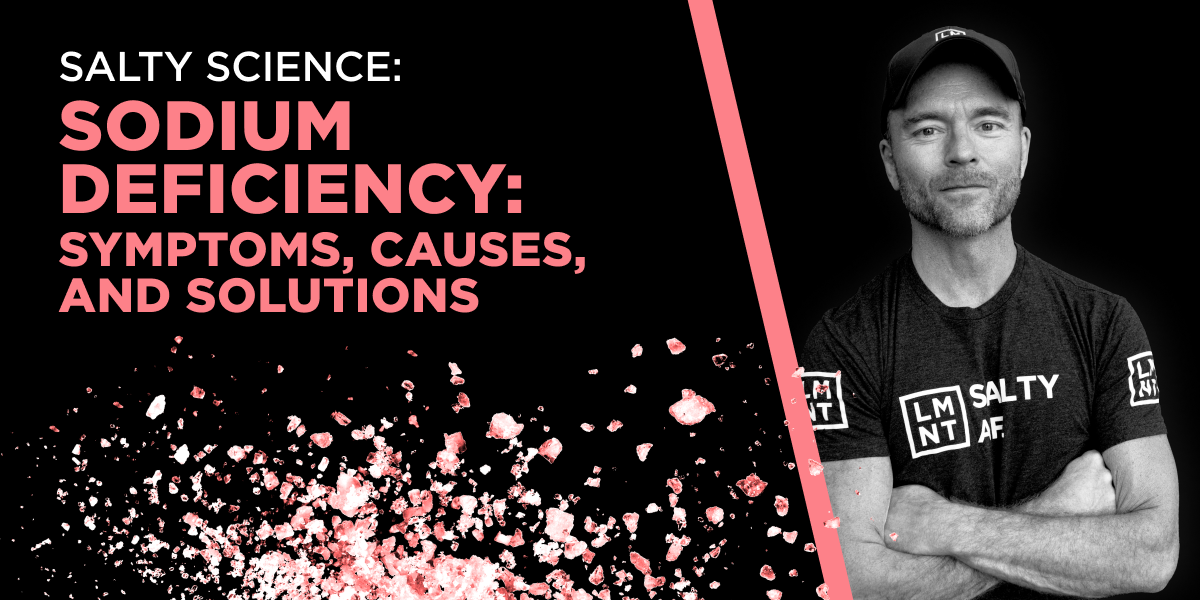Sodium deficiency can be difficult to detect, but it can also affect many aspects of your day-to-day life. You might feel “off” during a workout, foggy while planning a presentation, or low-energy throughout the day.
How widespread is sodium deficiency? In the low-carb, Paleo, and health-focused communities I’ve worked with, it’s almost ubiquitous. Healthy people live active lifestyles that accelerate sodium losses, and they often avoid sodium due to well-intended but widespread misinformation.
Because of this, most folks don’t recognize low sodium to be the cause of their symptoms, suspecting they’re feeling off due to stress, poor sleep, or dehydration. In reality, these folks need more salt, not less.
The neat thing is that if you’re deficient in sodium, increasing your sodium intake can lead to a noticeable improvement in how you feel and perform. No need to take my word for it — when you’re in a fog, eat some salty foods like pickles. You should feel the difference within minutes.
Now if you want to learn all the ins and outs of sodium deficiency, I wrote this article as your detailed guide — including how to identify symptoms, root out causes, and prevent a low-sodium slump.
The Need for Sodium
When people say that sodium is bad for you, I shudder. Sodium is an essential nutrient — and as is the case with all essential nutrients, you can consume too much OR too little. However, the health risks of consuming too little sodium are overlooked far more than the health risks of underconsuming other nutrients.
Electrolytes, especially sodium and potassium, are critical for fluid and electrolyte balance. Having an appropriate amount of water and electrolytes in your body is key for almost every facet of your health. Sodium in particular plays integral roles in the health of your brain, heart, bones, skin, hormones, and immune system.
Get it right and you’re sure to notice a difference in your general wellbeing and exercise performance. But short your body on electrolytes, and you short the system.
What Is Sodium Deficiency?
To be sodium deficient means you’re not consuming enough sodium to meet your individual sodium needs. It’s related to, but not the same as, a sodium imbalance.
A true sodium imbalance will show up on a blood electrolyte panel. For instance, hyponatremia (low blood sodium) generally results from heart failure, kidney failure, liver disease, cancer, vomiting, diarrhea, diuretic usage, or overhydration with plain water. Overwatering is a serious problem, especially among endurance athletes. Check out my article on exercise-associated hyponatremia to learn more.
A simple sodium deficiency — unlike low or high blood sodium — will not show up on a lab test. Why? Because when you underconsume sodium, your body employs a variety of sodium-retention tricks, including:
- Secreting renin and aldosterone (which can raise blood pressure) in order to absorb more sodium through the kidneys
- Secreting adrenaline and noradrenaline (which can raise heart rate, blood pressure, and cause insomnia)
- Scavenging your bones for sodium (bad news for bone density)
These symptoms are obviously not optimal, but they’re also difficult to detect. You don’t feel it when your body secretes sodium retention hormones. You don’t feel a slight reduction in bone density. So, what symptoms can you detect? I’m glad you asked.
Sodium Deficiency Symptoms
The most common symptoms of sodium deficiency include:
- Headaches
- Weakness
- Low energy
- Fatigue
- Muscle cramps
- Brain fog
- Insomnia
- Salt cravings (often mistaken for carb cravings)
- Irritability or other mood disruptions
The trick to preventing sodium deficiency is to consume enough salt to support your diet and lifestyle. On that note, let’s talk about a few factors which increase the risk of sodium deficiency.
5 Causes of Sodium Deficiency
Of all the electrolytes, sodium is the most neglected by health-conscious folks. Here are five reasons why.
#1: Fear of salt
Herb, drop that salt shaker! It’s bad for your heart!
Well-intended people have been exclaiming words like these since 1980. That was the year the government began explicitly warning us to avoid sodium. This anti-salt admonition still stands today on the basis that reducing sodium intake can lower blood pressure meaningfully in hypertensives.
That is true — people with high blood pressure may stand to benefit from sodium restriction (within reason) until their baseline health improves. But in normotensives, I have some concern that the negative effects of sodium restriction may outweigh the positive effects.
Nonetheless, people still fear the salt shaker. In my view, this irrational fear is the top cause of sodium deficiency.
#2: Whole foods diets
A healthy diet prioritizes whole foods over processed foods. This is a good thing in and of itself — whole foods contain a variety of beneficial compounds and nutrients that processed foods tend to lack.
Sodium is the exception to this rule. Whole foods don’t typically contain much (if any) sodium, whereas processed foods contribute over 70% of salt intake in the US. Therefore, people who avoid processed foods must rely on the salt shaker to meet their sodium needs.
#3: Low-carb diets and fasting
Through an interesting quirk of physiology, low-carb diets and periods of fasting cause humans to flush out sodium like a firehose shoots out water.
Why? Because lowering your intake of carbohydrates (or food generally) minimizes the hormone insulin. In turn, low insulin signals the kidneys to stop reabsorbing sodium. This phenomenon has been called the “natriuresis of fasting,” and it’s why clinicians keep the saline drip handy during medically supervised fasts.
#4: Sodium lost through sweat
You’d be surprised how much sodium is lost through sweat, and how much you can sweat in a single hour. An NHL team I work with reported their larger players lose up to 10 grams in a single training session—about 5 teaspoons of salt. If these folks were restricting their sodium intake to the government recommendation of 2.3 grams per day, they’d be in very bad shape.
The main factors that influence how fast you sweat and the amount of sodium in your sweat are:
- Genetics
- Body mass
- Temperature
- Heat acclimation
- Humidity
- Exercise intensity
- Exercise duration
- Airflow and clothing
When sodium isn’t sufficiently replaced during or after exercise, sodium deficiency follows. Check out these complete guides to calculating your sweat rate and sweat sodium concentration to learn more.
#5: Overhydration
You lose both sodium and water through sweat. Most people, however, only replace the water. This is an artifact of 8×8, the oddly persistent homespun wisdom that states we should drink eight, 8-oz. glasses of water per day. There’s no evidence supporting the 8×8 rule, but it’s still widely believed.
Drinking plain water beyond thirst can dilute blood sodium levels, which as I mentioned before, can catapult you straight past sodium deficiency and into hyponatremia. Endurance athletes are the most obvious victims of overhydration. Encouraged by frequent watering stations and well-intended but misinformed hydration advice, many drink on a set schedule.
While there are zero deaths from sports-related dehydration in the literature, this is unfortunately not the case for exercise-associated hyponatremia. Avoiding sodium and drinking excessive fluids can wreak havoc on your body. Instead, heed salt cravings and drink according to thirst, not beyond it. Thirst is a finely tuned mechanism and a great indicator of how much water you need.
How to Prevent Sodium Deficiency
To prevent sodium deficiency, simply consume enough sodium to support your diet and lifestyle. For most people, a good baseline is 4–6 grams per day (around 2–3 teaspoons of salt).
Pay attention to your body at different sodium intakes. How’s your energy, mood, and exercise on a typical day when you consume 4 grams? Do you feel materially better on a similar day when you consume 6 grams?
You’ll need to do some tinkering to find out. Keep the salt shaker close, and consider an electrolyte drink mix like LMNT. LMNT contains 1,000 mg sodium, 200 mg potassium, and 60 mg magnesium per stick pack. Simply add it to your water and drink to thirst!
If LMNT isn’t an option for you, that’s okay. You can follow this guide to make LMNT at home, or rely on salty foods like pickles and olives. However you get your electrolytes, Stay Salty.

